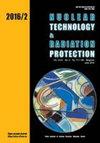The efficiency of gas-filled surge arresters in the environment contaminated by non-ionizing radiation of fusion reactors
IF 0.9
4区 工程技术
Q3 NUCLEAR SCIENCE & TECHNOLOGY
引用次数: 3
Abstract
The research presents an experiment with a model of an electronic generator for energy injection into the plasma of a fusion reactor. By recording a non-ionizing field in the vicinity of a fusion reactor, it was determined that this field has an extremely high growth rate. At the site of the maximum intensity of the field of non-ionizing radiation, commercial surge arresters with a flexible model of surge arresters were used for experimentation. It has been found that the commercial surge arresters have an efficiency of about 20%. For the efficiency of the flexible model, it was found to be slightly less than 40% (and to be achieved by the application of alpha particle radiation). Since neither of these efficiencies guarantee reliable operation of the gas-filled surge arrester, it was concluded that essential electronics in the vicinity of the fusion generator must be protected. However, since this protection can only be implemented in a fusion reactor, the fact remains that the environment of such a reactor is extremely contaminated with non-ionizing radiation. Commercial surge voltages are isolated for testing since the protection of electronic circuits from fast overvoltages is a critical point for the functioning of modern electronics.充气避雷器在核聚变反应堆非电离辐射污染环境中的效率
本文介绍了用电子发生器模型向核聚变反应堆等离子体注入能量的实验。通过记录核聚变反应堆附近的非电离场,确定了该场具有极高的生长速率。在非电离辐射场最大强度处,采用柔性避雷器模型的商用避雷器进行实验。研究发现,商用避雷器的效率约为20%。对于柔性模型的效率,发现它略低于40%(并且可以通过应用α粒子辐射来实现)。由于这两种效率都不能保证充气避雷器的可靠运行,因此得出结论,必须保护聚变发生器附近的重要电子设备。然而,由于这种保护只能在聚变反应堆中实施,因此这种反应堆的环境仍然受到非电离辐射的严重污染。商业浪涌电压被隔离以进行测试,因为保护电子电路免受快速过电压的影响是现代电子产品功能的关键点。
本文章由计算机程序翻译,如有差异,请以英文原文为准。
求助全文
约1分钟内获得全文
求助全文
来源期刊

Nuclear Technology & Radiation Protection
NUCLEAR SCIENCE & TECHNOLOGY-
CiteScore
2.00
自引率
41.70%
发文量
10
审稿时长
6-12 weeks
期刊介绍:
Nuclear Technology & Radiation Protection is an international scientific journal covering the wide range of disciplines involved in nuclear science and technology as well as in the field of radiation protection. The journal is open for scientific papers, short papers, review articles, and technical papers dealing with nuclear power, research reactors, accelerators, nuclear materials, waste management, radiation measurements, and environmental problems. However, basic reactor physics and design, particle and radiation transport theory, and development of numerical methods and codes will also be important aspects of the editorial policy.
 求助内容:
求助内容: 应助结果提醒方式:
应助结果提醒方式:


